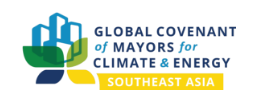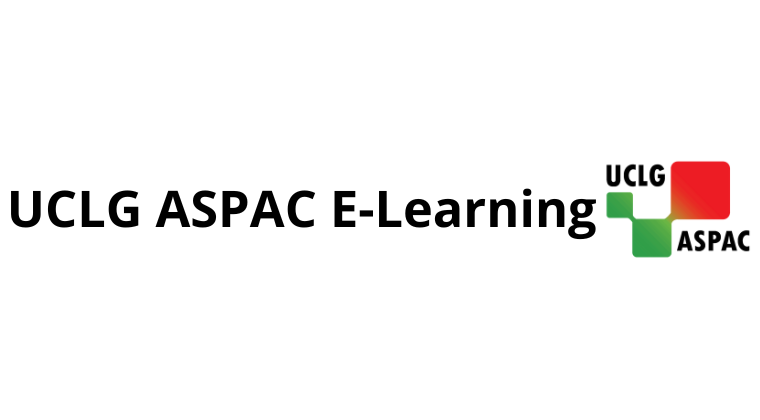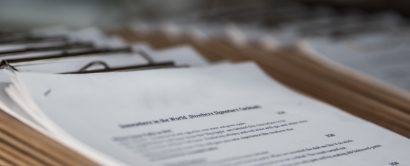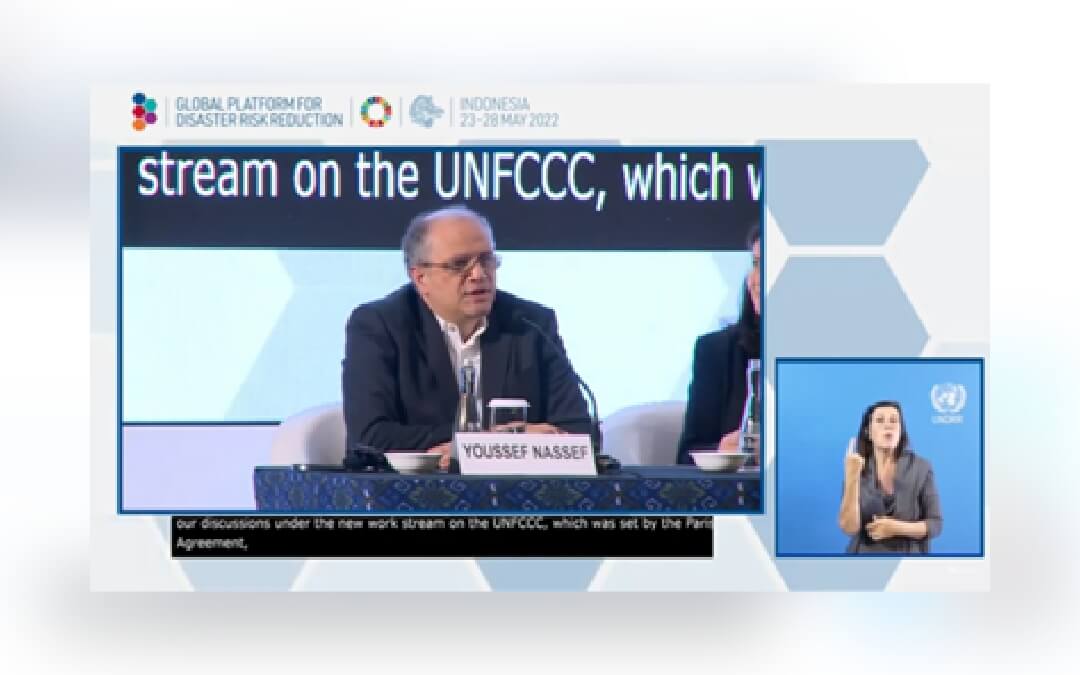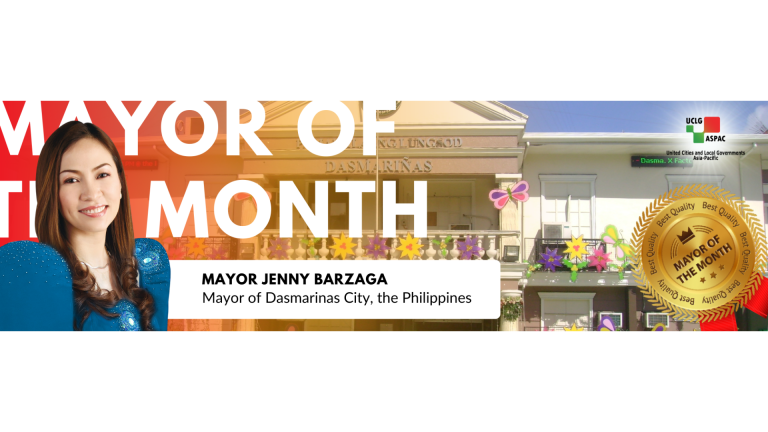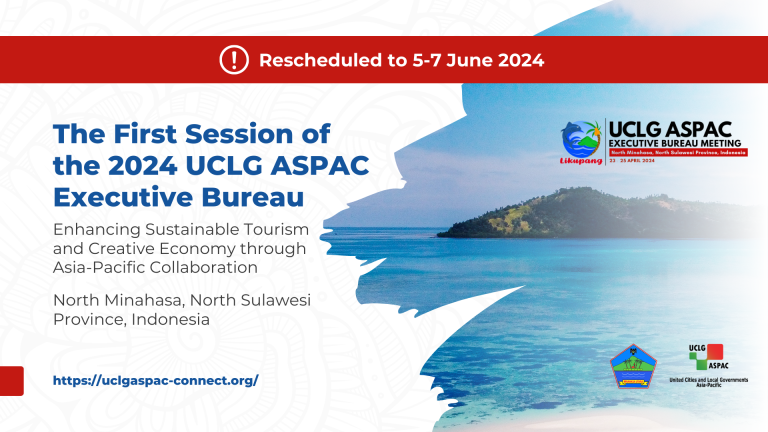The undeniability of climate impacts requires us to really recalibrate the way we work and make sense of existing norms. According to the recent IPCC reports and the Global Assessment Report, it was made clear that climate impacts will further intensify. That itself is a risk and for better risk reduction, there is a need to ensure interoperability of interventions and connect people, their experiences as well as insights, climate mitigation and adaptation initiatives, and approaches at the global, national, and subnational levels.
This fruitful session discussed the very detailed know-how and approach of designing an implementation plan before, during, and after disasters with examples of concrete actions for long term resilience. This session was moderated by Ms. Loretta Hieber Girardet (Chief, Risk Knowledge, Monitoring and Capacity Development Branch, UNDRR). So, here are the key points to keep in mind when scaling up actions in developing and long term resilience, which can also prepare everyone for the upcoming COP27 in Egypt.
As every session normally went, panelists will answer various questions, and the first sets the global context of resilience on hand: “What should we do to ensure the global goal of increasing resilience?” Mr.Youssef Nassef as Director, Adaptation Division, UNFCCC mentioned the need to look at the “thresholds of ambition” byensuring a minimum level of basic needs fulfillment in the face of disasters. The same goes for basic needs fulfillment of climate-induced disasters, and we need to focus on the goal of climate action, ensuring attainment and sustainability.
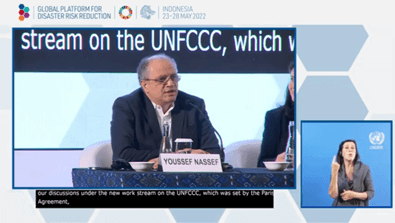
To accomplish that, climate action planning must include clear objectives and scale thinking, as well as ensuring thatthere is a balance between subjective context specific cultural components of determining climate action, which can be subjective, versus actual objectives. Besides that, he also mentioned the need for a collective intelligence process, which is thinkingtogether globally and move forward in making objectives, scale-thinking, and approach all the targets.
The next panelist was Victoria Salinas as(Acting) FEMA Deputy Administrator, USA. She shared some practices of how the USA thoroughly planned their disaster risk reduction efforts. She mentioned how the USA is using a combination of different plans and working together to make them work by understanding others’ roles (relevant stakeholders) and figure out how they can partner together. In addition to that, she conveyed how the United States has been moving from the framework of prevention and mitigation into a more national resilience framework.

However, , this is not enough as global leaders and all relevant stakeholders need to understand all the aspects and dimensions of risk reduction. Realizing this, the United States hasput a surmountable amount of effort in understanding and maximizing the use of hazards tools, a national resilience index, and various typesof guides for individuals and communities on anticipating and handling weather related-events.
In addition to tolls, the United States are also focused on building capacity for local governments for the implementation of disaster risk management and climate action in their respective regions. In the face of disasters, they started using and taking advantage of social vulnerability information which can be utilised by local governments to drive responsive actions towards disaster risks that can threaten socio-cultural stability. The results tend to show are signs of inequality. Therefore, upholding equity is a key tactic in tacklingenvironmental justice issues, as there are communities or groups that are disproportionately impacted by disasters, including those that are climate-induced
To end her remarks, Victoria said how history can be a great teacher and therefore, after disasters, the United States is going to make some substantial strides towards climate adaptation. With this substantial stride, they will be able to empower local governments about the future disaster risk.
Besides the USA Risk Reduction, Ms.Pannapa Na Nan as Director of International Cooperation, Department of Disaster Prevention and Mitigation, Ministry of Interior, Thailand shared about the country’s practices in disaster risk reduction. Back in 2011, Thailand experienced high flooding rate. After that, they were setting the goals according to what they had experienced. But, frequently that doesn’t qualify them in preparing for climate change or climate-induced disasters . Therefore, they are trying to reflect the new measures and find a new way of doing business, which is to switch from disaster response into disaster risk reduction and overall resilience.
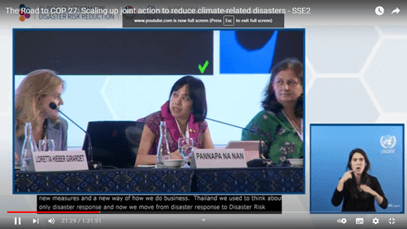
There are three (3)(factors in understanding the national framework that Thailand contributes to in adaptating to climate change: 1) policy commitment at the high level: at the highest national agenda. 2) integrated climate change adaptation and disaster management and reduction: in their social economic development plan. 3) capacity development at the local level andpromoting the actions. In addition to that, Thailand is collectively building the awareness and capacity of communities and individuals to battle disaster, while promoting overall anticipatory at theASEAN context.
She also mentioned how every risk should be addressed with a different disaster risk reduction plan which depends on the risk assessment. Besides that, we can not only have plans and strateges, but also the means to make these plans resilient.

The next panelist was Ms. Judith Kasperma as Head of Department (Flood Risk Management) Deltares, Netherlandsdescribing how the country is focusing its disaster risk prevention and reduction around the existing body of water close to these cities. For example, through financing, they are protecting their country. She also mentioned the various tips that Germany learned how to deal with water-related risks such as flooding bynot fighting the water. Therefore, she mentioned that we really need to work together with the government, private companies, and NGOs, meaning that we need to break down the silos between the different groups, hence acollaboration for a long-term approach. They learned that adaptation is an urgency and also opportunity and that we can learn from other countries in terms of risk reduction.

The next panelist was Ms. Zita Sebesvari Deputy Director, United Nations University – Institute for Environment and Human Security (UNU-EHS). In preparing efforts towards disaster risk reduction, andshe told us to focus on the global common. Global common means the global ambitions, investments and responsibility of our Earth’s system. Also, we need to realise the action plan at the local level. If we aggregate at the national level, there will be no layered approach that needs to be taken care of andno one would probably do anything.
The next panelist was Mr. Gernot Laganda as Chief of Climate and Disaster Risk Reduction Programmes, WFP to explain the idea of disaster risk management in the context of food security. He mentioned how so far, we are challenged at a global level when it comes to talking about adaptation goals, especially when looking at the well-being of the planet and the people through the prism of food security. He mentioned that even back in 2015 when hunger numbers were going down, they never went into a sustainable direction of ensuring food security for all. After the COVID-19, they still see the increasing and very abrupt changes faster than what is imagined. In comparison to 2019, they had around 135 million people in acute food crises. These crises are not only cause by the climate-induced or related disasters but is also a result of systemic and structural problems such as economic factors, economic disruptions, and the inflation of food prices.
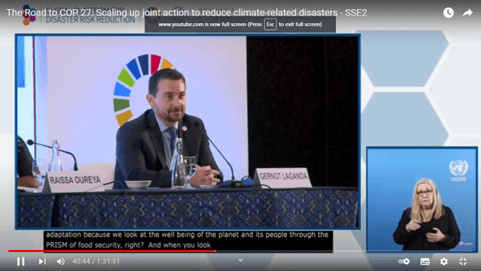
“Climate is a really important risk, but we need also to get back to the idea of having several thresholds”, he said. Therefore, he emphasised on how food security could also be a central metric of these conversations regarding disaster risk management because food scarcity could mean the absolute inability to adapt to climate change. Therefore, he coined a phrase of “no climate-induced famine on our watch.”

Last but not least, the next panelist was Ms. Raïssa Oureya – Jeunes Verts Togo, Member: GNDR to talk about the important role of stakeholders. She is concerned that there is little involvement of communities in implementing these climate projects; communities who are equipped with the detailed understanding of their local needs and challenges regarding disasters. In other words, communities are actually included in the list of importantstakeholders (women, youth, people with disabilities all have a collapse for input) that can make disaster risk management effective and inclusive. Also, she emphasised how we need to make sure that we hear the voice of the young, because they are able to build capacity, raise awareness, and strongly communicate about climate change and the impact of natural disaster.
To conclude, COP27 is going to place a strong focus on concrete solutions. Therefore, we need to collaborate with various parties and should consider people who are currently in high stages of vulnerability. Of course, concrete action with the sustainability approach is a must! Are you ready for COP27?
By KM Team


